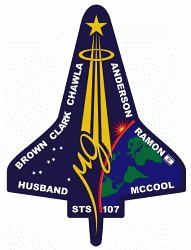
|
|
|
Brainerd Area Amateur Radio Club |
|
News from the ARRL February 1, 2003 |
 NEWINGTON, CT, Feb 1, 2003--All members of the
seven-person crew of space shuttle Columbia are feared dead after the
spacecraft broke up high over Texas today. Columbia was on its way to
what had been considered an uneventful landing at Kennedy Space Center in
Florida. Three of the crew members on the scientific mission were Amateur Radio
operators. NASA says communication was lost around 8 AM Central Time, and
unconfirmed reports indicated that debris has been spotted on the ground in
Texas. Aboard was the first Israeli to fly in space.
NEWINGTON, CT, Feb 1, 2003--All members of the
seven-person crew of space shuttle Columbia are feared dead after the
spacecraft broke up high over Texas today. Columbia was on its way to
what had been considered an uneventful landing at Kennedy Space Center in
Florida. Three of the crew members on the scientific mission were Amateur Radio
operators. NASA says communication was lost around 8 AM Central Time, and
unconfirmed reports indicated that debris has been spotted on the ground in
Texas. Aboard was the first Israeli to fly in space.
ARRL Field and Educational Services Manager Rosalie White, K1STO, who's been closely associated with the Space Amateur Radio EXperiment (SAREX) and Amateur Radio on the International Space Station (ARISS) programs expressed shock and sadness over the Columbia disaster. "We sincerely regret this latest tragedy," she said. "We will be keeping the families of these astronauts in our minds and hearts." White is ARISS International Secretary and the primary liaison between ARRL and the ARISS program. No Amateur Radio gear was aboard the Columbia for this mission.
The STS-107 crew, headed by Commander Rick D. Husband, also included Pilot William C. McCool and Mission Specialists Kalpana Chawla, KD5ESI; David M. Brown, KC5ZTC; Laurel B. Clark, KC5ZSU, Michael P. Anderson, and Payload Specialist Ilan Ramon--a well-known Israeli Air Force pilot who had waited two years for a chance to go into space.
Search-and-rescue crews have been deployed in Texas, although little hope exists that anyone survived the breakup. NASA has warned those on the ground to stay clear of any debris they might spot. NASA says shuttle debris may be contaminated with hypergolic fuel, the fumes of which can be fatal if inhaled. "If you find debris, please do not touch it, and if you have photos or videos that you think will be helpful, please contact your local police authorities," NASA said in a statement.
News video from Texas television stations--now being replayed across the country--apparently shows the Columbia disintegrating as it was approximately 207,000 feet (39 statute miles) above Earth. NASA said the first sign of trouble was a loss of radio and data (telemetry) contact with the shuttle.
A surveillance satellite reportedly detected what's been called a "heat spike" in space as Columbia approached Earth which could indicate an explosion aboard Columbia. President George W. Bush has convened a crisis team that involves members of the military, but it was not believed there was any terrorist link to the Columbia disaster.
STS-107 was NASA's 144th shuttle mission. Reminiscent of the 1986 Challenger disaster, which occurred as the spacecraft was going into space, the Columbia tragedy marked the first time a shuttle had encountered any problems during re-entry.
The Columbia broke up while traveling 12,500 MPH and a mere 16 minutes from touchdown in Florida, where the crewmembers' families were awaiting their arrival back on Earth following a 16-day research mission. Their duty tour had been described as routine. The Columbia did not visit the International Space Station while in space. The mission had been subjected to heavy security, however.
NASA has grounded all of its space shuttles, but there's no word yet that the Columbia tragedy will affect the current Expedition 7 crew's future aboard the International Space Station. More information may be available via the NASA Human Spaceflight Web page.
This story is from the American Radio Relay League. See http://www.arrl.org
![]() Back to the BAARC
History Page
Back to the BAARC
History Page
![]() Back to
2003
Back to
2003
This page was last updated 12/19/2006 Ø